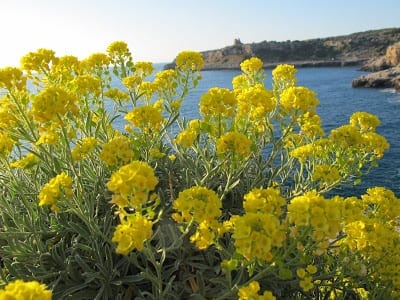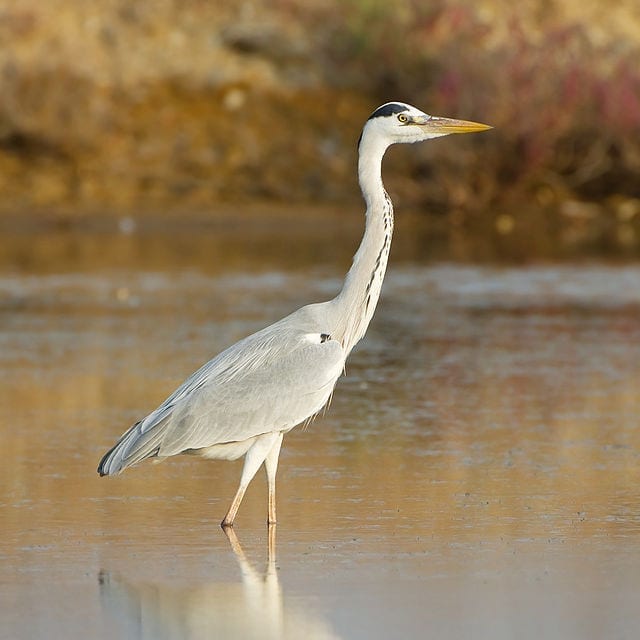Aeneas today
aeneas today
nature and landscapes along the Aeneas route
MOUNT IDA
Mount Ida is located in northwest Turkey, few kilometres far from the ancient Troy. The area falls within a natural reserve “Kazdağı National Park”, established in 1994. Mount Ida reaches 1.770 m a.s.l., being the highest mountain of Biga Peninsula and the Park covers an area of about 21.000 hectares (http://kazdagi.tabiat.gov.tr/). The landscape is various, with different types of forests, valleys, waterways and waterfalls. The Park is characterised by a high plant biodiversity, hosting more than 800 plant taxa, including 32 endemic species for the area (http://nationalparksofturkey.com/kazdagi-mount-ida-national-park/), such as Matthiola trojana, Asperula sintenisii, Thymus pulvinatus, Hypericum kazdaghense, Sideritis trojana, Armeria trojana, Centaurea athoa, Allium kurtzianum, Linum boissieri, just in the highest zone of the mountain (Ozturk et al. 2001), or the endemic tree known as “Kazdağı Fir” (Abies nordmanniana subsp. equi-trojani). Fauna is also rich in mammals, reptiles and birds and enhanced by the presence of some mammal endangered species, such as bear, wolf and roe deer (http://kazdagi.tabiat.gov.tr/).
TROY NATIONAL PARK (TURKEY)
The historical Troy National Park is located in Ezine district, was declared a national park in 1996 and has been included among UNESCO world heritage sites since 1998 (https://whc.unesco.org/en/list/849/). Beyond the great cultural value of the site, the area represents a pivotal zone for the preservation of the natural environment (https://www.troyexcavations.com/troia-tarihi-milli-parki/?l=en). The landscape id characterised by five main vegetation types: macchia (typical Mediterranean vegetation with shrubs and bushes), frigana (a particular formation resulting from the destruction of red pine – Pinus brutia – and macchia areas), forests (dominated by Quercus ithaburensis subsp. macrolepis and Ulmus minor subsp. canescens), wetlands and beach dunes. A great conservation interest is due to some plant species: Beta trojana var. trojana, included among the strictly protected flora species (Appendix 1) of Bern Convention and found in wetland areas; Aethionema saxatile subsp. oreophilum, a Critically endangered species, only collected in Troy ruins; Verbascum syriacum and Carduncellus caeruleus var. dentatus, identified as vulnerable species (Mutlu 2011).DELOS ISLAND (GREECE)
Delos is a tiny island in the Cyclades were Apollo was born, according to Greek mythology. The island is listed among UNESCO world heritage sites since 1990 (https://whc.unesco.org/en/list/530/). The archipelago belongs to the South Aegean Volcanic Arc (SAVA), considered one of the most significant geological structures in the Mediterranean, located between the African plate and the Aegean–Anatolian microplate. Despite the area is not protected by the establishment of Natural Parks, the archipelago hosts interesting environments and a rich flora and fauna, both maritime and terrestrial. In the Cyclades more than 1600 plant taxa were recorded and, among these, around 9.4% (157 taxa) are considered endemic (Kougioumoutzis and Tiniakou 2014). Also, the islands are an important site for many bird species, both residents or seasonal visitors (Magioris 1987).BUTRINT NATIONAL PARK (ALBANIA)
The Albanian city of Butrint is an important archaeological site, listed in UNESCO list since 1992 (https://whc.unesco.org/en/list/570/). The area was first declared a cultural monument in 1948; in 2003, the wetland complex, including the lagoon section and the coastal area of Butrint – Cape Stillo – was declared a Ramsar Zone and National Park (IUNC Category II for the Protected Areas Management Category). The 1600 ha tectonic lagoon (Butrint Lake) forms the wetland area, pivotal for the conservation of flora and fauna species, representing an important food and bird nesting site. Among plants, the area holds many rare species, e.g., Alkan corcyrensis, Limonium anfracium, Scobiosa epirota. Many species of amphibians, reptiles, birds and mammals live in the Park, including the wolf. Also, Butrint National Park is the only Albanian site where can be find animals like the Epirus water frog (Pelophylax epeiroticus) or the sand boa (Eryx sp.) (https://www.expoaus.org/al/parku-kombetar-i-butrintit-uso12).ARCHAEOLOGICAL SITE OF CARTHAGE (TUNISIA)
Located in the Gulf of Tunis, Carthage is an extensive archaeological site. The city was a metropolis of Punic civilization in Africa, funded at the end of the 9th century BC and the site is listed among UNESCO World Heritage Sites since 1979, occupying an area of over 600 ha (https://whc.unesco.org/en/list/37/). Beyond the priceless cultural value, the city hosts some wetlands that are pivotal for the enhancement of natural interest of the site. The main wetlands are represented by Sebkha Ariana, a permanent brackish to saline lake included among Wetlands of National Importance, and the Lake of Tunis, a large permanent brackish lake. Here, winter important populations of White-headed ducks (Azafzaf 2001). In the Lake of Tunis lies the Chikly Island, a natural reserve, hosting thousands of birds, such as flamingos during winter; in summer the island is frequented by dwarf terns (Sterna albifrons), plovers, gulls and little egrets (Egretta garzetta), which has become the symbol of this island.Cilento Vallo di Diano and Alburni National Park (Italy)
The Cilento Vallo di Diano and Alburni is a National Park, a UNESCO MAB (Man and the Biosphere) Reserve since 1997 and a UNESCO Global Geopark since 2010, located in southern Italy. The area hosts a high number of geosites and is s characterised by low dolomite mountains with typical karst features such as sinkholes and caves (http://www.unesco.org/new/en/natural-sciences/environment/ecological-sciences/biosphere-reserves/europe-north-america/italy/cilento-and-vallo-di-diano/). The Nature 2000 Network occupies a surface of around 120 hectares (the 65% of the whole Park), with 28 Sites of Community Interest (SCI) and 8 Special Protection Areas (SPA). Among the fauna, the most important species are represented by the otter, the Apennine wolf, the Italian hare (recently confirmed as a new species) and the wild cat. The flora is enhanced by the presence of Primula palinuri, a glacial relict endemic of some coastal areas of the Tyrrhenian southern Italy, Genista cilentina and Soldanella sacra, two endemisms of the Park, and Minuartia moraldoi, a rare and recently identified species (http://www.cilentoediano.it/en/man-and-the-biosphere-mab).Castelporziano Presidential Estate (Italy)
Castelporziano Presidential Estate is located near Rome and inside a wider protected area represented by the Roman Coastal National Reserve, established in 1996. The Presidential Estate covers a surface of about 6 hectares and includes several historic hunting grounds (https://palazzo.quirinale.it/residenze/c_porziano_en.html). The Residence hosts two Sites of Community Interest (SCI). The first one is linked to the coastal environment and is characterised by the presence of several habitats protected by the Habitats Directive (Council Directive 92/43/EEC), such as dunes with annual or perennial vegetation, matorral and wet grasslands. The second SCI is referred to hygrophilous oak forests, characterised by the presence of two priority habitats: Pseudo-steppe with grasses and annuals of the Thero-Brachypodietea and Mediterranean temporary ponds (http://vnr.unipg.it/habitat/).These habitats are home of equally important and protected animals, e.g., Emys orbicularis (European pond turtle), Testudo hermanni (Hermann’s tortoise) and Triturus carnifex (Italian crested newt).Ancient Lavinium (Italy)
The archaeological site of Ancient Lavinium, few kilometres far from Rome, hosts a 48 hectares wide Site of Community Interest (SCI) included in the Nature 2000 network (Council Directive 92/43/EEC). The designation of the site is linked to the presence of a priority habitat, identified by the code “5230* Arborescent matorral with Laurus nobilis” (http://vnr.unipg.it/habitat/cerca.do?formato=stampa&idSegnalazione=94). These woods characterised by the dominance of laurel in the upper layer and, here, the formation extends for around 15 hectares. This kind of woods deserve a high conservation priority since they represent a relict in the rest of Italy and Europe, increasingly rarefied (http://www.regione.lazio.it/binary/rl_main/tbl_documenti/AMB_DGR_159_14_04_2016_Allegato1.pdf). The botanical value of the site is also linked to the presence of rare or uncommon species for the Lazio Region (e.g., Fraxinus excelsior, Quercus petraea and Melica minuta). Celtis australis (European nettle tree) populations are also valuable, being rare, and poorly documented at national and international level. Finally, monumental specimens for size must be mentioned, as in the case of some Quercus suber (cork oak) and European nettle tree plants.CASTRO (ITALY)
The city of Castro (Apulia, southern Italy), lies hosts a Special Protection Areas (SPA) named “Parco delle Querce di Castro” (literally, Castro oak park), an interesting Quercus ilex (evergreen oak) wood covering a surface of about 5 hectares (https://www.gazzettaufficiale.it/eli/id/2018/04/09/18A02342/SG).The area is included in the wider context of the “Parco Naturale Regionale Costa Otranto – S.Maria Leuca – Bosco Tricase”, protecting more than 50 kilometres of coast and 3200 hectares of territory (http://www.parks.it/parco.costa.otranto/index.php). The park hosts five Sites of Community Interest (SCI), including limestone slopes, cliffs with Mediterranean vegetation (and endemic species of the genus Limonium), evergreen oak woods, Quercus macrolepis (Valonia oak) woods and submerged and semi-submerged see caves. The flora is characterised by several endemic species, such as Centaurea leucadea, Aurinia leucadea, Ephedra campylopoda (with its sole Italian presence) and the very rare Vicia giacominiana (http://www.parcootrantoleuca.it/).TRAPANI (ITALY)
Located in north-west Sicily, Trapani overlooks the Tyrrhenian see. Four Sites of Community Interest (SCI) fall within the municipality territory (http://www.parks.it/regione.sicilia/index.php?prov=TP). The “Saline di Trapani” (Trapani salt plans) represent one of the last and pivotal Sicilian coastal wetlands. The area hosts an important floristic endemism, Calendula maritima, and is the link between the European and African continents for the migratory birdlife (http://www.salinenatura.it/). The second SCI is represented by “Saline dello Stagnone” (Stagnone salt plans), the largest lagoon in Sicily, with a surface of more than 2000 hectares (http://www.trapani-sicilia.it/saline.htm).The “Marausa: Macchia a Quercus calliprinos” SCI is a small coenosis with a remarkable botanical interest, mainly due to the presence of Israeli oak. These forests, once distributed along coasts of western and southern Sicily, are nowadays almost disappeared due to the anthropization of this areas (Natura 2000 Standard Data Form – http://www.wwfpreola.it/download/sic/ita010012.pdf). Finally, the SCI “Montagna Grande di Salemi”, although altered by human pressure, shows interesting botanical and faunal interest, with the presence of several endemic plants and orchids (Natura 2000 Standard Data Form – https://natura2000.eea.europa.eu/Natura2000/SDF.aspx?site=ITA010023).CUMA (ITALY)
The archaeological site of Cuma acropolis is located in the Municipality of Pozzuoli, near Naples, in southern Italy. Near the archaeological area, along the coast, lies the “Foce Volturno Costa di Licola” Natural Reserve. The Reserve occupies an area of 1,540 hectares and has been established since 1993 (http://www.parks.it/riserva.foce.volturno.licola/par.php). The area hosts several habitats, including the Patria lake, coasts, wetlands and pine groves and represents an important site for the avifauna. Notable is the presence of many species of migratory birds, e.g., kingfishers (Alcediniae) or the grey heron (Ardea cinerea). Landscape is mainly characterised by the typical Mediterranean vegetation, with macchia shrublands interrupted by pine groves.References:
Azafzaf, H. (2001). White-headed Ducks in Tunisia. Nature, 141, 020.
Kougioumoutzis, K., & Tiniakou, A. (2014). Ecological factors driving plant species diversity in the South Aegean Volcanic Arc and other central Aegean islands. Plant Ecology & Diversity, 8(2), 173–186.
Magioris, S. N. (1987). Check-list of the bird species have been observed in Cyclades, Aegean-Greece, during 19th and 20th century. Ecologia mediterranea, 13(1), 15-22.
Mutlu, B. (2011). Plant wildlife and threatened vascular flora of Truva (Troy) national park, Turkey. Hacettepe J. Biol. &Chem, 39(1), 45-50.
Ozturk, M., Uysal, I., Karabacak, E., & Celik, S. (2011). Plant species microendemism, rarity and conservation of pseudo-alpine zone of Kazdaği (Mt. Ida) national park-Turkey. Procedia-Social and Behavioral Sciences, 19, 778-786.
Territories
- Mount Ida (Turkey)
- Troy National Park (Turkey)
- Delos Island (Greece)
- Butrint National Park (Albania)
- Archaeological Site of Carthage (Tunisia)
- Cilento Vallo di Diano and Alburni National Park (Italy)
- Castelporziano Presidential Estate (Italy)
- Ancient Lavinium (Italy)
- Castro (Italy)
- Trapani (Italy)
- Cuma (Italy)



















































